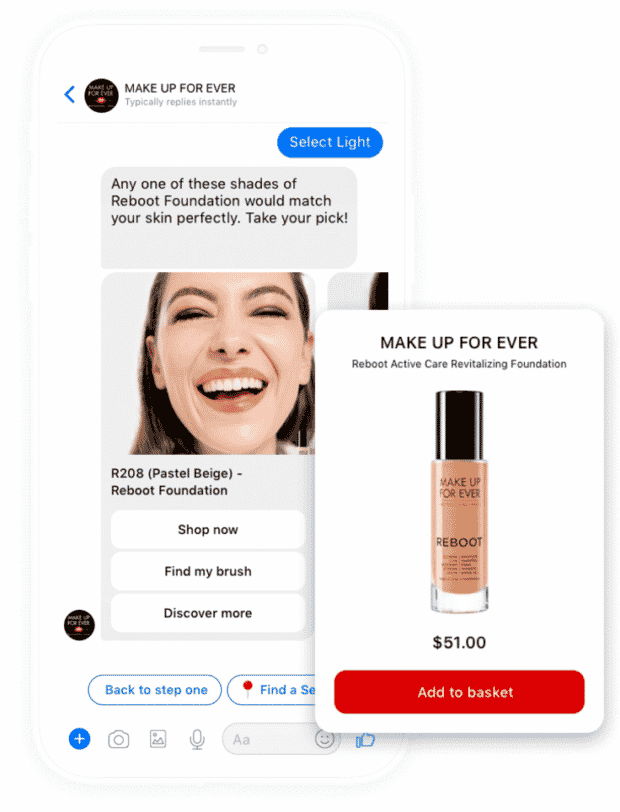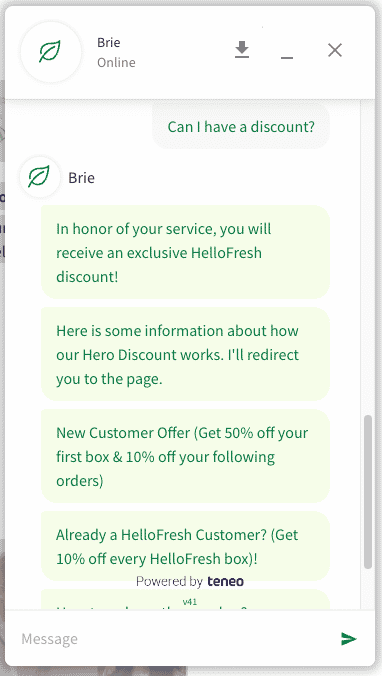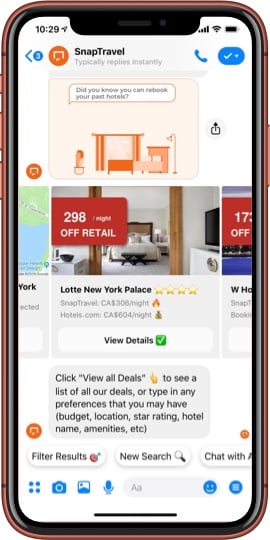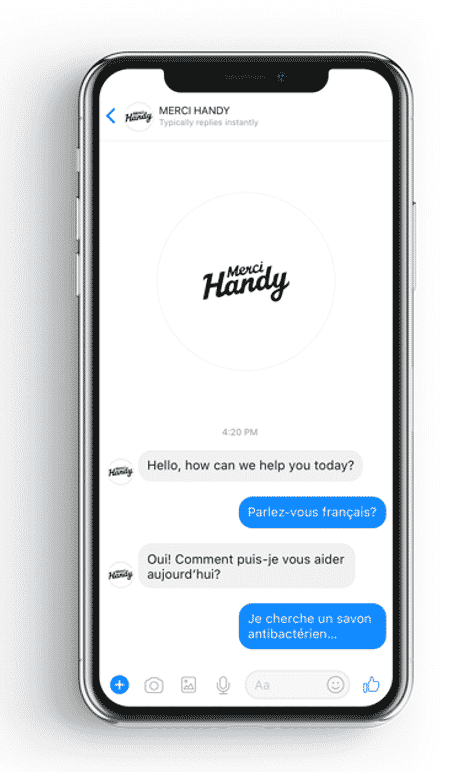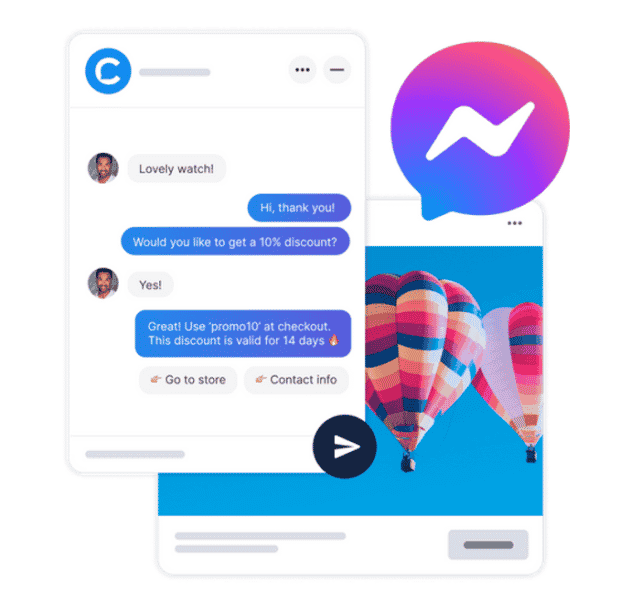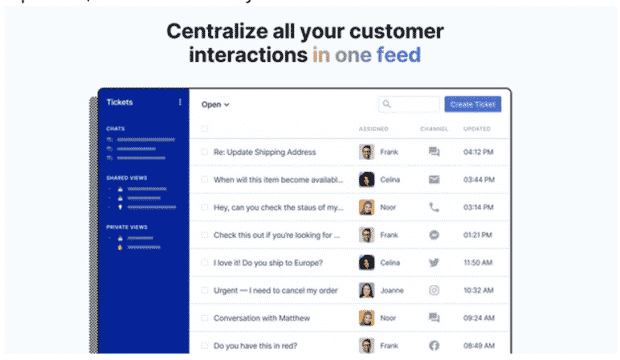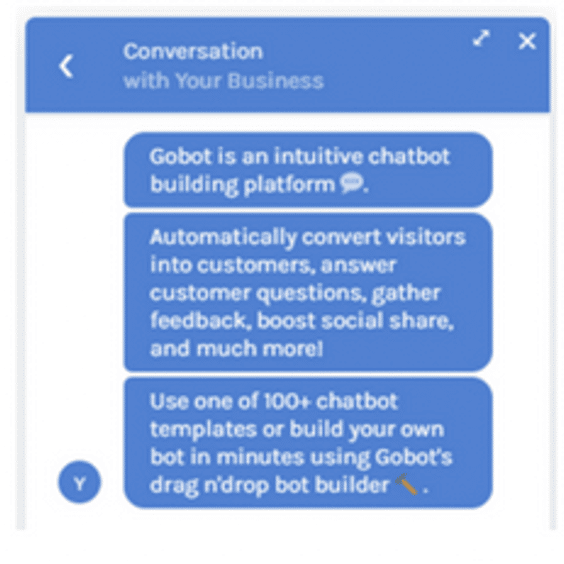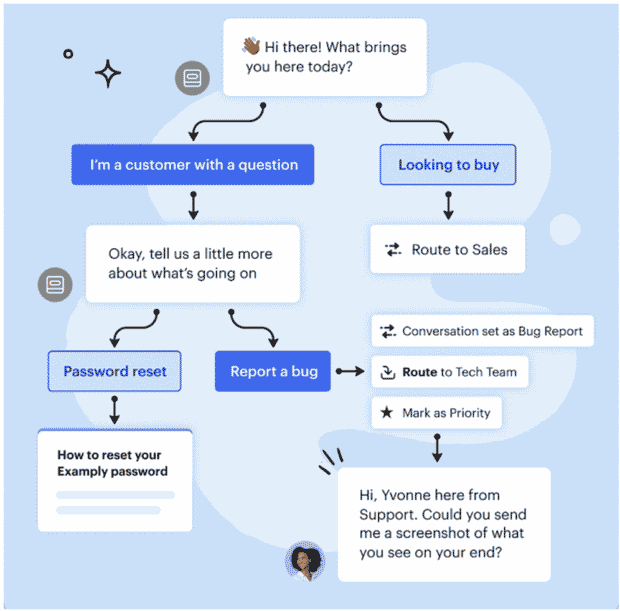Everything You Need to Know About Chatbots for Business
Imagine having an employee on your team who is available 24/7, never complains, and will do all the repetitive customer service tasks that your other team members hate.
Bonus: They cost a fraction of your average employee’s salary.
This unicorn of a worker exists, just not in the traditional human sense. Chatbots are many businesses’ next competitive edge. The multiple benefits of chatbots give them a ton of bang for their buck.
We’ll explain everything you need to know about chatbots for business, from what they are to how they can help your bottom line. Plus, we’ll give you tips on the dos and don’ts of common business best practices with chatbots and a few recommendations of which chatbots to use.
Bonus: Get a free, in-depth guide to The Why, What, and How of Social Commerce. Learn how to sell more products on social media and delight your customers without relying on cookies.
What is a chatbot?
Chatbots are computer programs designed to learn and mimic human conversation using artificial intelligence (AI) called conversational AI. There are a few best practices that feed into conversational AI.
Businesses commonly use chatbots to help customers with customer service, inquiries, and sales. But that’s just scratching the surface of how you can use chatbots for business.
Chatbots can be programmed to respond to certain keywords in a specific way. Or, you can use machine learning to train your chatbots to respond organically.
Chatbots can help your business:
- Make sales
- Automate customer service
- Execute tasks
With chatbots worked into your overall digital strategy, you’ll be alleviating frustrating manual tasks from your team’s day-to-day. And you’ll be saving on labor costs in the long run.
How do chatbots work?
Chatbots work by responding to your questions, comments, and queries either in a chat interface or through voice technology. They use AI, automated rules, natural language processing (NLP), and machine learning (ML).
For those who are unsure of the above terms but curious:
- Automated rules are like directions or instructions for your chatbot
- Natural language processing combines linguistics, computer science, and artificial intelligence. NLP is how computers can process and analyze human language.
- Machine learning is a kind of AI that allows software applications to accurately predict outcomes on their own. ML relies on historical data to help with its predictions. Basically, it uses any and all information available to make guesses about what it should do next.
“Chatbot” is a fairly large umbrella term. The truth is, chatbots come in many shapes and sizes. But, we can give you the broad strokes.
Types of chatbots
There are two main camps for chatbots: Smart and simple.
- Smart chatbots are AI-driven
- Simple chatbots are rule-based
And, because nothing can ever be that straightforward, you can have hybrid models. These are a mix of both simple and smart.
Essentially, simple chatbots use rules to determine how to respond to requests. These are also called decision-tree bots.
Simple chatbots work like a flowchart. If someone asks them X, they respond with Y.
You’ll program these bots in the beginning to do your bidding. Then, so long as customers are clear and straightforward in their questions, they’ll get to where they need to go. These bots do not like to be surprised.
Smart chatbots, however, use machine learning to understand the context and intent behind questions or queries. These bots generate answers using natural language processing. Natural language processing isn’t a new phenomenon; it’s been around for over 50 years. But, much like AI, it’s only now being realized as a powerful tool in business.
And the best part of smart chatbots is the more you use and train them, the better they become. Conversational AI is incredible for business but terrifying as the plot of a sci-fi story.
Not only can businesses benefit from using a conversational AI tool for customer inquiries and FAQs, but they’re also now being used for customer support and social commerce on social media platforms.
8 reasons why you should use chatbots for business
There are so many benefits for chatbots in business. But, everyone’s favorite tends to be the cold hard cash you’ll save. That and not having to respond to the same message over and over and over again.
Here are eight reasons why you should work chatbots into your digital strategy.
Improve response time for customer service queries
Slow, unreliable customer service is a profit-killer. One of the best ways to improve sales is to improve your response time. In our current age of instant communication, people expect faster response times.
By using chatbots to automate responses, you can help your customers feel seen, even if it’s just to say you’ll match them up with a representative as soon as possible. People who feel heard and respected are much more inclined to buy from your brand.
Automate sales
Chatbots can automate sales tasks for you. They can help lead your customers through the sales funnel, even processing payments.
Chatbots can also qualify leads for your agents. They’ll take them through an automated process, eventually pulling out quality prospects for your agents to nurture. Your sales team can then turn those prospects into lifelong customers.
FAQ
By relieving your team from answering frequently asked questions, chatbots free up your team to concentrate on more complex tasks. FAQ chatbots can improve office productivity, save on labor costs, and ultimately increase your sales.
Automate customer service tasks
You can outsource simple customer service tasks to your chatbot. Use them for things like comparing two of your products or services, suggesting alternate products for customers to try, or helping with returns.
24/7 support
One of the most significant advantages that chatbots have is their always-on capabilities. Having 24/7 support in place means your employees can take valued time off, and your customers can have their questions answered during holidays and after-hours.
<h3Avoid human error
Chatbots won’t be short or sarcastic with your customers — unless you program them to be that way. They have endless patience for questions they’ve already answered a million times. You can trust chatbots not to make the same mistakes humans might.
Save on time and labor
With chatbots, you’re buying a computer program, not paying someone’s salary. You’ll be saving from paying a human being to do the same work. And this way, the human beings on your team are free to do more complex and engaging work.
Multi-language support
If they’re programmed to be multilingual (and many are), then chatbots can speak to your audience in their own language. This will increase your customer base and make it easier for folks to interact with your brand.
The dos and don’ts of using chatbots for business
Chatbots are a great resource, but they shouldn’t be your one and only tool. Make sure you’re not relying on them for more than you should be. And that you are using them correctly to maximize your investment.
There are a few basic do’s and don’ts to follow to get the most out of your chatbot.
DO let human agents handle complicated inquiries
There are some things that need to be handled by a human being. Complicated inquiries or ones full of emotion are among those. Program your bot to hand queries they can’t answer off to someone on your team.
DON’T spam
The last thing your customers want is a ton of marketing junk about how great your brand is. It’s a fast way to get someone to bounce off your page and never return.
Don’t use chatbots for evil. Don’t spam.
DO give your chatbot some flair
Chatbots with personalities make it easier for folks to relate to them. When you create your bot, give it a name, a distinct voice, and an avatar.
Source: Reddit
DON’T give your chatbot too much flair
Don’t let your little robot go hog wild. When you overshoot the mark, you might make it difficult for folks to engage with your bot. There’s nothing worse than trying to return a pair of shoes and being met with 100 dad jokes instead. Give them a personality, but don’t sacrifice function for flair.
DO let your customers know what your chatbot can do
Have your chatbot introduce itself and its capabilities to your customers. This way, they’ll be able to get the most out of your bot. This can be as simple as, “Hi, I’m Bot Name, and I can help you with purchases, returns, and frequently asked questions. What’s on your mind today?”
DON’T try to pass your chatbot off as human
People know. Believe us, no matter how well you think you’ve designed your bot, people know it’s not a human they’re talking to. Just be honest. These days people are receptive to using chatbots for customer service inquiries. The goal isn’t to recreate the human experience but to augment it.
DO make it easy to understand
Your chatbot isn’t the next great American novel. Use simple language and write in concise sentences. Keep it short.
DON’T send big blocks of text
You might have a lot of information to get across, but please, don’t send it all at once. Big blocks of text are hard for people to read. Program your chatbot to send pieces of text one at a time so you don’t overwhelm your readers.
DO expect the unexpected
If you prime your chatbot with the tools to use when it’s faced with unforeseen situations, you’ll set yourself, and your customers, up for success. Give it a way to apologize in a friendly manner when faced with data it’s not sure what to do with.
For example, your chatbot can say, “Sorry! Despite my good looks and charming attitude, I am still a robot and am not sure how to handle this request. Let me send you over to my BFF and deskmate Brad, he’ll be able to help you.”
DON’T disregard buttons
Buttons are a great way to list out your bots’ capabilities or frequently asked questions. People love having readily-made options. Just don’t make them too limiting or ignore text altogether.
Bonus: Get a free, in-depth guide to The Why, What, and How of Social Commerce. Learn how to sell more products on social media and delight your customers without relying on cookies.
Examples of chatbots
So, now you know why and how to use chatbots for your business. The next step is to give yourself a visual of how a chatbot would work for your business.
Here are a couple of examples of chatbots in action.
Make Up For Ever: Sales automation
In the past, shoppers would have to search through an online store’s catalog to find the product they were looking for.
Now, shoppers can simply type in a query, and a chatbot will instantly recommend products that match their search. This not only saves time but also ensures that shoppers are always able to find the products they’re looking for.
Chatbots are quickly becoming the new search bar for eCommerce stores — and as a result, boosting and automating sales.
Source: Heyday
HelloFresh: Social selling feature
HelloFresh’s bot is more than just a means of answering questions. It also has a built-in social selling component that offers discounts to users who ask about them.
The bot is named Brie to keep in line with HelloFresh’s casual brand voice. It automatically redirects you to the Hero Discount Program page when you ask for a discount. This has the added benefit of improving the user experience with the bot. People love it when you make it easy to save money!
Source: HelloFresh
SnapTravel: Messaging-only pricing
Here’s an example of how SnapTravel is using a messenger bot as the basis of its eCommerce model. It has people engage in a conversation with the bot via Facebook Messenger or SMS in order to access exclusive travel deals.
Source: SnapTravel
TheCultt: Raising conversions and automating FAQs
Automating common customer requests can have a big impact on your business’s bottom line. TheCultt used a ChatFuel bot to provide instant and always-on support for pesky FAQs about price, availability, and goods condition.
In three months, TheCultt decreased response time by 2 hours, raised customers’ loyalty, and reassured them they weren’t being ignored.
Owner and operator Yana Kurapova said the chatbot “helps our customers to know that we’re having a day-off, not ignoring them. It increases our customers’ loyalty and is seen in sellers’ and customers’ feedback.”
Wealthsimple: Conversational AI
This example shows the chatbot leveraging information from Wealthsimple’s databases alongside its Natural Language Understanding capabilities. This way, it provides customized responses to Wealthsimple’s customers’ questions.
Plus, the chatbot detects customer intent, so it’s sure to have a response for whatever people throw at it.
Source: Wealthsimple
Heyday: Multilingual bots
This bot picks up French immediately so the customer can have a conversation in their preferred language. This can help you to increase your customer base by catering to folks who speak a different language from your team.
Source: Heyday
The 5 best chatbots in 2022
In the past few years, we’ve seen many unprecedented things — notably, eCommerce growth. And, with eCommerce growth comes chatbot growth. They’re two parts of the digital marketing ecosystem that have thrived during stay-home orders and lockdowns.
You can find chatbots specific to the platform your audience prefers or multi-channel bots that will speak across platforms from one central hub. With so many to choose from, it can be overwhelming to even start. But don’t worry — we’ve compiled a list of chatbot examples to help you get started.
Out of all the simultaneous chaos and boredom of the past few years, chatbots have come out on top. Here are five of the best of the best chatbots in 2022.
1. Heyday
Heyday’s dual retail and customer-service focus is massively beneficial for businesses. The app combines conversational AI with your team’s human touch for a truly sophisticated experience.
Heyday easily integrates with all of your apps — from Shopify and Salesforce to Instagram and Facebook Messenger. If you’re looking for multi-channel messaging, this app is for you.
Now, Heyday offers both an enterprise product and a Shopify app. Whether you’re 100% eCommerce or have multi-location brick-and-mortar shops with eCommerce offerings, there’s an option for you.
Have customers from around the globe? Heyday’s chatbot is bilingual. The beauty of using Heyday is that your customers can interact with your chatbot in either English or French.
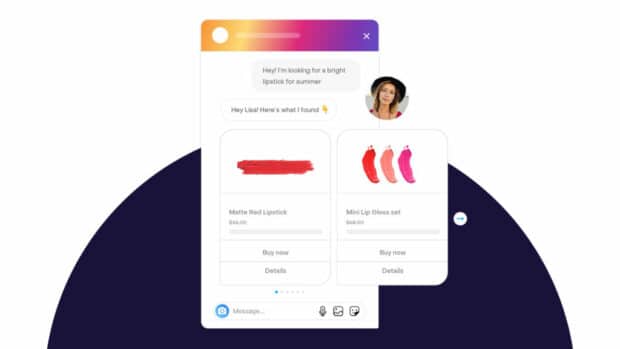
Source: Heyday
2. Chatfuel
Chatfuel has a visual interface that’s aesthetically pleasing AND useful, unlike your ex. The front-end has customizable components so you can mold it to better serve your customers.
You can build free Facebook Messenger chatbots with Chatfuel. However, some of the swanky tools are only available on a pro account.
Source: Chatfuel
Head here for more on how to improve your social commerce.
3. Gorgias
Gorgias works well as a Shopify chatbot for stores that receive complex feedback or need a more in-depth customer support model. It employs a help desk model so your organization can stay on top of multiple support requests, tickets, feedback from customers, and live chat.
Gorgias is pretty focused on eCommerce clientele — if your organization isn’t fully eCommerce, it might be best to look elsewhere. Also, if you need robust reporting capabilities, this chatbot isn’t for you.
Source: Gorgias on Shopify
4. Gobot
When it comes to Shopify apps, Gobot stands out from the crowd with its templated quizzes.
An AI-powered chatbot, Gobot makes recommendations based on what customers like or need, thanks to natural language processing. The prebuilt templates and questions in their shopping quiz make it easy for users to find what they’re looking for.
If you’re not very tech-savvy, however, this app can pose challenges. The support team isn’t readily available to help with setup — some users have reported frustration here.
Source: Gobot
5. Intercom
Intercom has 32 language capabilities. If you’re a global company with consumers from all over the world, this may be the chatbot for you. You can easily customize your bot and automate answers for 24/7 global support, letting your team have the downtime they need.
That being said, the app does have a few pain points where user-experience is concerned.
Intercom also works with startups. So if your business is just getting off the ground, you may want to inquire about their startup pricing models.
Source: Intercom
Engage with shoppers on social media and turn customer conversations into sales with Heyday, our dedicated conversational AI chatbot for social commerce retailers. Deliver 5-star customer experiences — at scale.
Turn customer service conversations into sales with Heyday. Improve response times and sell more products. See it in action.
Free DemoThe post Everything You Need to Know About Chatbots for Business appeared first on Social Media Marketing & Management Dashboard.
Categories
- 60% of the time… (1)
- A/B Testing (2)
- Ad placements (3)
- adops (4)
- adops vs sales (5)
- AdParlor 101 (43)
- adx (1)
- algorithm (1)
- Analysis (9)
- Apple (1)
- Audience (1)
- Augmented Reality (1)
- authenticity (1)
- Automation (1)
- Back to School (1)
- best practices (2)
- brand voice (1)
- branding (1)
- Build a Blog Community (12)
- Case Study (3)
- celebrate women (1)
- certification (1)
- Collections (1)
- Community (1)
- Conference News (1)
- conferences (1)
- content (1)
- content curation (1)
- content marketing (1)
- contests (1)
- Conversion Lift Test (1)
- Conversion testing (1)
- cost control (2)
- Creative (6)
- crisis (1)
- Curation (1)
- Custom Audience Targeting (4)
- Digital Advertising (2)
- Digital Marketing (6)
- DPA (1)
- Dynamic Ad Creative (1)
- dynamic product ads (1)
- E-Commerce (1)
- eCommerce (2)
- Ecosystem (1)
- email marketing (3)
- employee advocacy program (1)
- employee advocates (1)
- engineers (1)
- event marketing (1)
- event marketing strategy (1)
- events (1)
- Experiments (21)
- F8 (2)
- Facebook (64)
- Facebook Ad Split Testing (1)
- facebook ads (18)
- Facebook Ads How To (1)
- Facebook Advertising (30)
- Facebook Audience Network (1)
- Facebook Creative Platform Partners (1)
- facebook marketing (1)
- Facebook Marketing Partners (2)
- Facebook Optimizations (1)
- Facebook Posts (1)
- facebook stories (1)
- Facebook Updates (2)
- Facebook Video Ads (1)
- Facebook Watch (1)
- fbf (11)
- first impression takeover (5)
- fito (5)
- Fluent (1)
- Get Started With Wix Blog (1)
- Google (9)
- Google Ad Products (5)
- Google Analytics (1)
- Guest Post (1)
- Guides (32)
- Halloween (1)
- holiday marketing (1)
- Holiday Season Advertising (7)
- Holiday Shopping Season (4)
- Holiday Video Ads (1)
- holidays (4)
- Hootsuite How-To (3)
- Hootsuite Life (1)
- how to (5)
- How to get Instagram followers (1)
- How to get more Instagram followers (1)
- i don't understand a single thing he is or has been saying (1)
- if you need any proof that we're all just making it up (2)
- Incrementality (1)
- influencer marketing (1)
- Infographic (1)
- Instagram (39)
- Instagram Ads (11)
- Instagram advertising (8)
- Instagram best practices (1)
- Instagram followers (1)
- Instagram Partner (1)
- Instagram Stories (2)
- Instagram tips (1)
- Instagram Video Ads (2)
- invite (1)
- Landing Page (1)
- link shorteners (1)
- LinkedIn (22)
- LinkedIn Ads (2)
- LinkedIn Advertising (2)
- LinkedIn Stats (1)
- LinkedIn Targeting (5)
- Linkedin Usage (1)
- List (1)
- listening (2)
- Lists (3)
- Livestreaming (1)
- look no further than the new yorker store (2)
- lunch (1)
- Mac (1)
- macOS (1)
- Marketing to Millennials (2)
- mental health (1)
- metaverse (1)
- Mobile App Marketing (3)
- Monetizing Pinterest (2)
- Monetizing Social Media (2)
- Monthly Updates (10)
- Mothers Day (1)
- movies for social media managers (1)
- new releases (11)
- News (72)
- News & Events (13)
- no one knows what they're doing (2)
- OnlineShopping (2)
- or ari paparo (1)
- owly shortener (1)
- Paid Media (2)
- People-Based Marketing (3)
- performance marketing (5)
- Pinterest (34)
- Pinterest Ads (11)
- Pinterest Advertising (8)
- Pinterest how to (1)
- Pinterest Tag helper (5)
- Pinterest Targeting (6)
- platform health (1)
- Platform Updates (8)
- Press Release (2)
- product catalog (1)
- Productivity (10)
- Programmatic (3)
- quick work (1)
- Reddit (3)
- Reporting (1)
- Resources (34)
- ROI (1)
- rules (1)
- Seamless shopping (1)
- share of voice (1)
- Shoppable ads (4)
- Skills (28)
- SMB (1)
- SnapChat (28)
- SnapChat Ads (8)
- SnapChat Advertising (5)
- Social (169)
- social ads (1)
- Social Advertising (14)
- social customer service (1)
- Social Fresh Tips (1)
- Social Media (5)
- social media automation (1)
- social media content calendar (1)
- social media for events (1)
- social media management (2)
- Social Media Marketing (49)
- social media monitoring (1)
- Social Media News (4)
- social media statistics (1)
- social media tracking in google analytics (1)
- social media tutorial (2)
- Social Toolkit Podcast (1)
- Social Video (5)
- stories (1)
- Strategy (603)
- terms (1)
- Testing (2)
- there are times ive found myself talking to ari and even though none of the words he is using are new to me (1)
- they've done studies (1)
- this is also true of anytime i have to talk to developers (1)
- tiktok (8)
- tools (1)
- Topics & Trends (3)
- Trend (12)
- Twitter (15)
- Twitter Ads (5)
- Twitter Advertising (4)
- Uncategorised (9)
- Uncategorized (13)
- url shortener (1)
- url shorteners (1)
- vendor (2)
- video (10)
- Video Ads (7)
- Video Advertising (8)
- virtual conference (1)
- we're all just throwing mountains of shit at the wall and hoping the parts that stick don't smell too bad (2)
- web3 (1)
- where you can buy a baby onesie of a dog asking god for his testicles on it (2)
- yes i understand VAST and VPAID (1)
- yes that's the extent of the things i understand (1)
- YouTube (13)
- YouTube Ads (4)
- YouTube Advertising (9)
- YouTube Video Advertising (5)


